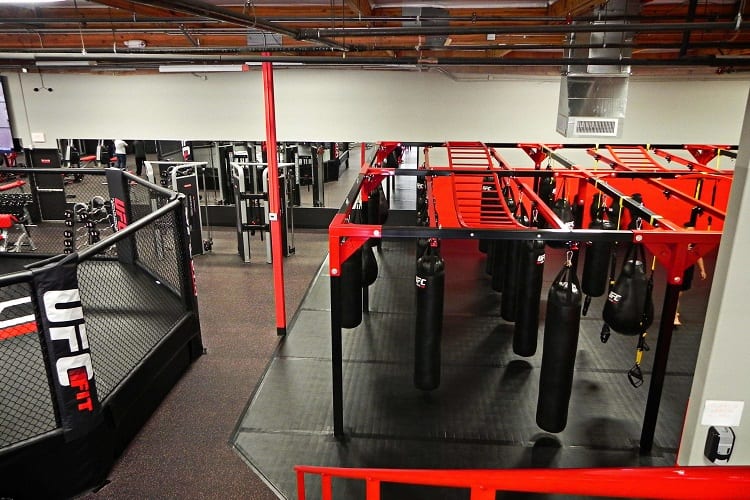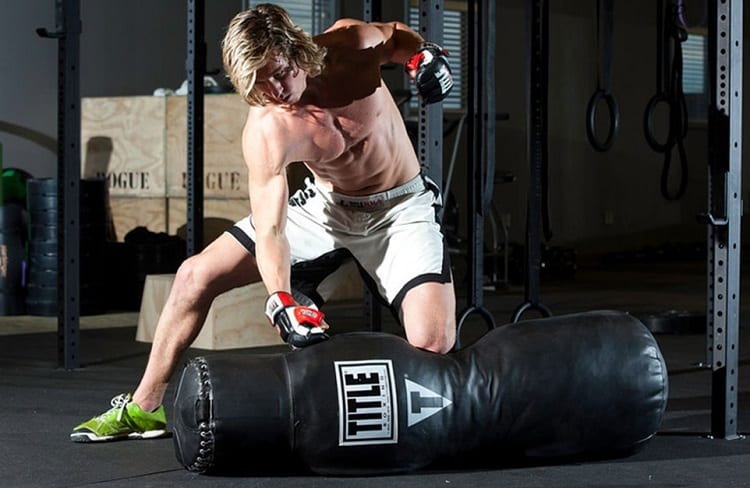You’ve been watching the fights, studying the techniques, taking classes at your local gym, and now you’re ready for the next level in your mixed martial arts practice.
There’s only so much you can do visiting a gym a few times a week and if you’re someone usually short on time, this frequency will be even less.
Building a home MMA gym is a rite of passage for those who take this sport seriously, and if you’re at the stage where you want to commit more time to train and improving your MMA fitness, it’s the most obvious next step.
Thankfully, there’s not much that goes into one of these setups, but the results it can help you achieve with regular practice will be astounding.
How do you build an MMA gym at home?
An MMA gym consists of basics like a training dummy, punching bag, and boxing gloves, with enough room to use them all freely. A home gym can be as elaborate or as basic as your budget and free space allows you, but these items are a good place to start.
With full-time access to a gym at home, the privacy and convenience to train whenever you want, and free reign to develop a training schedule that suits your goals, you’ll have it all.
This is the next step for a serious martial artist who’s ready to commit more of their time and energy to their passion, and it’s easily done with just a few key ingredients.
The Difference Between a Gym and an MMA Gym

Building an MMA specific gym at home is much like building a regular gym, and it’s up to the individual to choose gear that suits their fitness and training goals.
If your dream is to have an MMA specific training facility in the comfort of your own home, everything in it should have the purpose of either improving your martial arts practice or general fitness.
A standard MMA gym has enough space for practicing your art, like dedicated floor mats for wrestling and grappling work, as well as adequate room for striking at different ranges.
You’ll need some basic cardio gear to keep your fitness up, and martial arts specific items like punching bags, boxing gloves, wrestling dummies, and garments required to practice the techniques.
The purpose of your home MMA gym will also dictate what equipment you have in it and how much space you need.
You might want to spend all of your training time in there building on your skills, otherwise, it can be used as a place where you keep your fitness up during the week in between more serious training sessions at your dedicated MMA gym.
What Type of Equipment Do You Need For Your MMA Gym?
Choosing the perfect gear to make your MMA home gym a reality is the biggest task, but when done right, you’ll have everything you need to build your technique and skills.
We’ve categorized the essential items you’ll want in your gym so it can rival a professional training center, and you can add or subtract from our list as you wish.
Pre Workout Gear
No athlete on earth gets straight into training without warming up their body first, and you shouldn’t be any different. In your home gym, you’ll want a few simple pieces that can help you prepare for the training session, so consider adding these to the space.
- Jump rope: A jump rope is the easiest way to warm up with a cardio workout and one that takes up minimal floor space.
- Floor mat: A cushioned floor mat can reduce the impact of a workout, prevent injury and abrasion doing groundwork, and give you a dedicated space for training.
- Attire: To get the full effect of your martial arts training, consider investing in a pair of MMA shorts or a jiu-jitsu gi that can improve your technique and help you to move freely.
Work Out Equipment
These are the basics you’ll need for a home MMA gym, with the freedom to keep adding more gear as you need it. With these few items, you’ll have a range of workouts to choose from and be able to train in most MMA proficiencies.
- Bags: Having some options for bags including a reflex bag, heavy bag, and speed bag can ensure you’re improving the precision, power, and speed of your strikes.
- Boxing Gloves: A pair of quality boxing gloves that allow you to work the bag without abrasion or injury, and practice clinches and grabs on opponents.
- Training dummy: A submission dummy is useful for grappling, wrestling, and strike practice.
Post Workout
When the workout is over, you’ll need to spend the right amount of time cooling down and stretching your muscles.
A foam roller is the best piece of equipment for this, and can even be used in the warm-up stage as well. These rollers target specific muscle groups, reduce injury, and release tension, which is useful for recovery from a grueling martial arts workout.
The Space and Size Needed for an MMA Gym

Any well-coordinated gym has been set up not just to have room for the equipment, but so its participants have ample space to move around freely as well.
In terms of mixed martial arts practice, you’ll want enough space for all kinds of things, from wrestling on the ground to practicing strikes.
At a minimum, you should aim for at least 10’ x 10’ for a home MMA gym, giving you room for all aspects, including Brazilian jiu-jitsu.
With striking practice, you might want an extra couple of feet so that you can practice the moves in various ranges, so make sure you’ve mapped out the gym correctly.
Depending on what gear you have in there, you’ll need to make sure there’s adequate space on either side of it. A jump rope can be used with a relatively small footprint, but something like a heavy bag that can be tackled at all angles will take up more space around it.
Before you start putting equipment in the gym, it’s important to draw up a blueprint of where everything will go.
Have exact measurements of the gear you’ll have in there, the size of the room, and where it all needs to be placed to give you the most spacious workout area that won’t put any restrictions on your training.
Possible Locations for Your Gym

With an idea of how much room you need to fit your gear in, you’ll then have to scout locations for where you can build it.
This will be determined usually by your home and what space you have available there, but even without a spare garage or basement to transform into a gym, there are still loads of options for practicing martial arts.
Backyard
If you prefer the open-air style of training and the weather permits, you might want to set up a backyard gym at home.
Training outdoors has pros and cons to consider, but if you have a good climate that allows for this type of workout, it can be a refreshing way to work out.
If you do go the backyard route, make sure the gear you choose is suitable for outdoor use, otherwise, you’ll be investing in new equipment sooner than you think.
Garage
A garage is one of the most popular places at home to build a gym, and for an MMA gym, it can be the perfect location.
If your garage has already been insulated and has a power supply to it, you’ll be one step ahead, and can just move your gear straight in. You’ll be able to walk just a few steps to your MMA gym and even train with the garage door open when the weather permits.
Spare room
Some homes are big enough to have one or two spare rooms, and if nobody’s already claimed it, you can turn one of these into a home MMA gym.
The good thing about using a spare room inside the house is that you can train in any weather, but make sure it’s big enough to fit all of your gear and give you adequate space for movement.
Basement
A finished basement can become anything you want it to be, and it’s one of the spaces at home that’s truly big enough to create an epic gym.
You’ll be pretty much soundproofed to work out as loudly and aggressively as you want, and with ample space for all of your training moves.
Tent
If you like the idea of a backyard workout but want some protection from the elements, consider erecting a tent to house all of your gear.
As long as you have a larger tent, at least 10’ x 10’, you’ll be able to workout with enough room, and without the expensive costs of having to build something in the backyard.
Depending on where you choose to put your new gym, be sure to educate yourself on the laws and regulations surrounding such a building.
For those planning on erecting a new structure in their backyard, even an open-air one, there’s a good chance you’ll need a building permit from your municipality to ensure its safety and that it won’t be a distraction for other neighbors.
Home Gyms vs Memberships: Which is Best?
The debate over whether a home gym is better than a professional gym depends entirely on the individual and what they hope to gain from it.
One home gym is going to be different to the next, but if it’s set up correctly and has all of the right gear, there’s no reason why this can’t be your predominant place to work out.
The best part of having your own MMA gym at home is the freedom to work out whenever you want, and with the gear and equipment, you prefer. However, they lack the professional guidance that a true gym can offer, and there might only be so much you can do on your own.
Having a membership at an MMA gym can be beneficial for learning the correct way to do things, but it can be daunting, especially for newcomers to the sport.
The costs of membership will vary as well, and for many, it’s cheaper to invest in some quality gear for home than having to pay ongoing fees to work out somewhere else.
If you’re like many serious MMA athletes and can afford to, spending some time in your home gym and the rest training in a professional facility is the smartest way to work out.
This lets you get professional training from coaches and instructors at a gym, and then space and equipment to continue to build on this knowledge you’ve learned in the comfort of your own home.
Related Questions
Building a home MMA gym might seem like a huge undertaking, but it only requires a few essential pieces of gear and a commitment to training to be successful.
If you’re thinking about upping your game when it comes to martial arts training, we’ve got the answers to some questions that can help you out.
What Techniques Are Used in MMA?
Mixed martial arts is a hybrid sport where participants engage in full-body combat, combining techniques from disciplines like Muay Thai, Brazilian jiu-jitsu, wrestling, and boxing.
Those competing and training in MMA usually train to become proficient in certain styles and techniques, rather than being skilled in each one, and use this to defend themselves against their opponent.
How Often Do MMA Fighters Train?
A mixed martial artist can spend over 10 hours per week in training, and even more depending on their level of skill and upcoming contests.
The large majority of this workout is improving technique, with the rest of strength and conditioning. For at-home MMA training, it depends on the individual and what goals they have for their practice.

